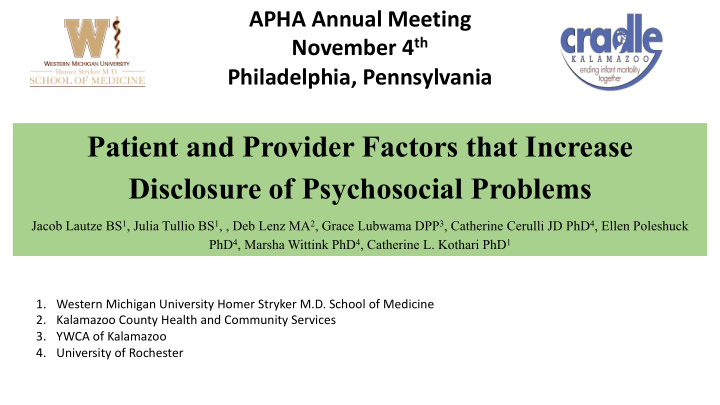



APHA Annual Meeting November 4 th Philadelphia, Pennsylvania Patient and Provider Factors that Increase Disclosure of Psychosocial Problems Jacob Lautze BS 1 , Julia Tullio BS 1 , , Deb Lenz MA 2 , Grace Lubwama DPP 3 , Catherine Cerulli JD PhD 4 , Ellen Poleshuck PhD 4 , Marsha Wittink PhD 4 , Catherine L. Kothari PhD 1 1. Western Michigan University Homer Stryker M.D. School of Medicine 2. Kalamazoo County Health and Community Services 3. YWCA of Kalamazoo 4. University of Rochester
DISCLOSURE There are no financial disclosures related to study Sponsors: This study was funded by United Way of Battle Creek Kalamazoo Foundation and by Healthy Babies Healthy Start (Kalamazoo County Health and Community Services). Study findings have been informed by Cradle Kalamazoo partners and Kalamazoo community members.
Background • Psychosocial risk factors include domestic violence (DV), mental illness (MH), and substance abuse (SA). • These common risk factors are harmful to health, especially during pregnancy. • Both providers and patients face multiple barriers to disclosure.
Research Objective • Describe rates of prenatal disclosure and the factors associated with disclosure. Psychosocial Risk Factors Domestic Substance Mental Illness Violence Abuse Disclosure
Methods • DESIGN: Prospective cross-sectional • SAMPLE: 300 postpartum women • RECRUITMENT: Postpartum hospital floors Bronson & Borgess (January-September, 2017) • • DATA COLLECTION: Mixed Methods Telephone survey conducted 2 months postpartum • Abstraction medical records • • ANALYSIS: Pearson Chi Square, Linear regression, α <.05
Recruitment Eligible, 471 Not, Approached, 426 45 No differences Not, 126 Consented, 300 by race or SES Not, Completed 56 Survey, 244 Reasons for not completing: -2 Withdrew from study -32 Never reached -22 Declined survey when reached
Measures
Domestic Violence Screen
Mental Illness Screen
Substance Abuse Screen
Results 45.00% In total, 57.3% of women screened • positive for 1 or more psychosocial 40.00% problems. 35.00% 30.00% 25.00% 20.00% 15.00% 10.00% 5.00% 0.00% Prenatal Depression Past Year Problem Drinking Domestic Violence
Results Proportion of Women that Screened Positive for 1 or More Problems 1 problem 2 problems 3 problems
Results Disclosure Rates of Different Problems Disclosure rates varied by • problem type. Substance Abuse Domestic Violence Mental Health 0.00% 10.00% 20.00% 30.00% 40.00% 50.00% 60.00%
Results Factors that increased disclosure Multiple Problems Lower Income
Results • Provider factors were not significantly associated with disclosure. • Provider factors include: • Medical Home • Primary Care Provider • Provider Relationship
Limitations • Majority of limitations are related to the measures
Conclusions • Disclosure of psychosocial problems, which are common among pregnant women, was more related to patient circumstances than to provider characteristics
Implications • We are applying a medical model to a social problem. • Normally we ask, diagnose and then treat. • This needs to be chipped because there are so many barriers in being able to successfully treat.
Recommend
More recommend